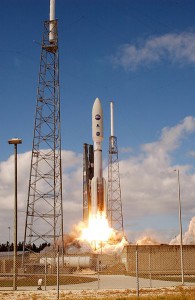
Sixteen days from now, the first robotic emissary from Earth will encounter the dwarf world Pluto, its large binary companion Charon, and a system of at least four tiny moons: Nix, Hydra, Kerberos, and Styx. In doing so, NASA’s New Horizons mission—led by Principal Investigator (PI) Dr. Alan Stern of Southwest Research Institute (SwRI) Space Studies Dept. in Boulder, Colo.—will bring full-circle humanity’s first-time reconnaissance and exploration of each of the traditionally accepted nine planets in the Solar System; although Pluto was officially demoted to the status of dwarf planet in 2006, fierce debate continues to rage about its nature. In recent days, our resolution of this tiny world has grown clearer, from distant, monochromatic images of a body of highly contrasting albedo ranges to the first views in near-true color of the Pluto-Charon duo in motion. As our spacecraft draws closer to its target, AmericaSpace’s New Horizons Tracker and a series of articles by Mike Killian, Leonidas Papadopoulos, and myself will follow the spacecraft’s progress as it seeks to make this unknown world known.
As recounted in yesterday’s AmericaSpace Pluto article, Dr. Stern’s “New Horizons: Shedding Light on Frontier Worlds” mission proposal was accepted in November 2001 for a Phase B Preliminary Design Study, just pipping to the post the Pluto and Outer Solar System Explorer (POSSE) concept of Dr. Larry Esposito of the University of Colorado at Boulder. Dr. Stern’s team consisted of staff from SwRI, together with the Johns Hopkins University (JHU) Applied Physics Laboratory (APL), near Laurel, Md., Stanford University in Stanford, Calif., Ball Aerospace of Broomfield, Colo., and a team of 20 science team co-ordinators for a Phase B Preliminary Design Study, the conditions of which required passage through a confirmation review to address significant risks of schedule and technical milestones and regulatory approval for launch of the spacecraft’s nuclear power source, together with the availability of funding.
“Congress provided $30 million in FY 2002 to initiate PKB spacecraft and science instrument development and launch vehicle procurement,” NASA explained. “However, no funding for subsequent years is included in the Administration’s budget plan.” In acknowledging the selection of New Horizons, NASA Associate Administrator for Space Science Dr. Ed Weiler pointed out that both proposals were outstanding, but Dr. Stern’s mission “represented the best science at Pluto and the Kuiper Belt, as well as the best plan to bring the spacecraft to the launch pad on time and within budget.”
Funding the mission proved troublesome, and Sen. Barbara Mikulski (D.-Md.), chair of the appropriations subcommittee responsible for NASA’s annual budget, successfully secured $30 million in June 2001 to begin initial design work. However, it was readily apparent that a December 2004 launch opportunity could not be met, and Dr. Stern’s team looked instead at the January 2006 JGA window. “I am going to fight to restore the funding for Pluto this year so we can make a 2006 launch and get the best science for the scientists and the best value for the taxpayer,” said Sen. Mikulski, quoted in the Baltimore Sun in March 2002. “Delaying the mission will just increase the cost and decrease the science.” However, there remained skepticism that even the later launch date was realistic. “Taking a year out would be suicide for the mission,” Dr. Stern was quoted by the Baltimore Sun. “I think our supporters in the public and in Congress would see it as an attempt to actually kill it.”

“A key aspect of this battle was meeting Dr. Weiler’s challenge that NASA and the [George W. Bush] Administration would support New Horizons if the soon-to-be-finalized National Research Council (NRC) Decadal Report in Planetary Sciences ranked PKB as the highest priority new start for Solar System exploration,” Dr. Stern subsequently noted in his historical overview paper. “Owing to the scientific significance of the Kuiper Belt exploration in general, and Pluto system exploration in particular, this was accomplished in the summer of 2002, thereby largely ending funding battles over the mission, though severe cash-flow difficulties persisted into FY03.” Efforts by planetary exploration advocacy groups, most notably The Planetary Society, proved instrumental in lobbying senior Congressional leaders on the Senate’s Appropriations Committee to properly fund the New Horizons mission. At length, full funding was granted in FY 2004.
At face value, the 13-month delay to New Horizons’ launch—from December 2004 to January 2006—implied a nominal five-year delay to the Pluto rendezvous from mid-2012 until mid-2017. During the summer and early fall of 2002, the mission advanced through its Systems Requirements Review (SRR) and Mission Preliminary Design Review (PDR) milestones. In July, a Star-48 solid-fueled booster was selected to provide New Horizons’ third propulsive stage, and, a year later, in July 2003, the Atlas V launch vehicle—flying in its most powerful configuration, the “551,” equipped with a 16-foot-diameter (5-meter) Payload Fairing (PLF), five strap-on rocket boosters, and a single-engine Centaur upper stage—was selected to deliver New Horizons into space during a month-long “window,” extending from 11 January through 14 February 2006.
In doing so, the Atlas V would inject the spacecraft onto an Earth-escape and solar-escape trajectory and—with a relative velocity of 36,373 mph (58,536 km/h)—would yield the fastest departure velocity ever accomplished by a human-made machine from the Home Planet. Moreover, by launching during the first half of this window, before 3 February, it would be possible to encounter Jupiter and pick up a JGA boost in early 2007. The enormous gravitational impetus imparted by the Solar System’s largest planet would shave about five years off the journey time, permitting a Pluto arrival in July 2015.
During the development of New Horizons, both the spacecraft and its instruments evolved considerably. Issues with fuel production for the plutonium-fed Radioisotope Thermoelectric Generator (RTG) power source led to a 15 percent power decrease at Pluto from design planning and also added over 110 pounds (50 kg) in dry mass. The high-gain antenna was reduced in size from 10 feet (3 meters) to 7 feet (2.1 meters) to reduce mass, the on-board solid-state memory was increased, heavier Sun-trackers were fitted when advanced units stalled in the production phase, and the positioning of thrusters was changed to accommodate a decreased risk of plume impingement and fuel-line routing.
Structurally, the 1,040-pound (470-kg) New Horizons is about the same size and shape as a baby grand piano, attached to the large high-gain antenna, and in this respect is not dissimilar in physical appearance to the joint U.S.-European Ulysses solar polar explorer. Triangular in shape, it measures 2.5 feet (0.76 meters) in thickness and has both spin-stabilization for its long cruise to Pluto and three-axis-stabilization for its science-gathering operations, all controlled by 16 hydrazine thrusters. Its General Purpose Heat Source (GPHS) RTG nuclear power device was originally a spare for the Saturn-bound Cassini mission and carried 24 pounds (10.9 kg) of plutonium-238 oxide pellets.
From an instrumentation perspective, the PERSI instrument was split into two distinct instruments: the “Alice” ultraviolet imaging spectrometer to determine Pluto’s atmospheric composition, and the “Ralph” telescope, equipped with a visible-light Multispectral Visible Imaging Camera (MVIC) and the near-infrared Linear Etalon Imaging Spectral Array (LEISA). Developed later than Alice, Ralph received its name in honor of Alice’s husband in the U.S. sitcom, The Honeymooners. The PAM unit was similarly broken down into the SWAP and PEPSSI instruments, the former of which measures charged particles at energies up to 6.5 keV and the latter up to 1 MeV. The Long-Range Reconnaissance Imager (LORRI)—which, since January 2015, has yielded many tantalizing monochromatic images as New Horizons drew closer to Pluto—carries a long-focal-length Charge-Coupled Device (CCD) with high resolution and responsivity at visible wavelengths.

The Radio Science Experiment (REX)—whose team tragically lost a pair of APL engineers in a small aircraft accident, late in 2001—draws upon the heritage of the Ultrastable Oscillator (USO) from the earlier PKE mission concept and seeks to conduct radio science investigations at the Plutonian system, utilizing New Horizons’ communications channels. The seventh and final instrument is the first student-built device ever flown on a planetary mission. The Student Dust Counter (SDC) was named in honor of Venetia Burney in June 2006 and sought to perform dust measurements continuously throughout its long journey out of the Solar System. “I feel quite astonished, and to have an instrument named after me is an honor,” said Venetia Burney Phair. “I never dreamt when I was 11, that after all these years, people would still be thinking about this and even sending a probe to Pluto. It’s remarkable.”
In December 2006, Dr. Stern and a small New Horizons team visited Mrs. Phair at her Epsom home in Surrey, England, and presented her with a plaque, certificate, and spacecraft model. Sadly, she would not live to see the spacecraft reach the diminutive world which she had named in the early spring of 1930. “She was a thoroughly intelligent, likable and endearing woman,” said Dr. Stern after Mrs. Phair’s death, aged 90, in April 2009. “The entire New Horizons team is saddened by her passing.”
Between September 2004 and March 2005, the instruments were delivered for integration, as New Horizons’ physical structure steadily took shape. Environmental testing at Johns Hopkins University APL and at NASA’s Goddard Space Flight Center (GSFC) in Greenbelt, Md., followed through the early summer of 2005, and, in late September, the spacecraft was shipped aboard an Air Force C-17 cargo aircraft to Cape Canaveral Air Force Station, Fla., for launch. It underwent “end-to-end” systems testing, loading of its hydrazine propellants, and final spin-balance tests, before it was transported to Space Launch Complex (SLC)-41 for integration aboard the Atlas V 551 booster. Liftoff was targeted to occur during a 34-day “window,” which extended from 11 January through 14 February 2006.
Seventy-five years had passed since Pluto’s discovery by Clyde Tombaugh, and since its naming by Venetia Burney, and almost a half-decade had by then elapsed since New Horizons was first conceived and named. Much had been learned about the small world in three-quarters of a century—its size and orbital mechanics had been approximately ascertained, as had the presence of its binary companion, Charon, together with the presence of smaller moons, a tenuous atmosphere, and a highly contrasting surface—but even advances in Earth-based and Earth-orbiting telescopic technology were no substitute for a close-range reconnaissance.
That was New Horizons’ goal.
This series will continue next weekend, as AmericaSpace explores New Horizons’ long voyage to Pluto and investigates the circumstances surrounding the controversial 2006 demotion in Pluto’s status.
Want to keep up-to-date with all things space? Be sure to “Like” AmericaSpace on Facebook and follow us on Twitter: @AmericaSpace
Missions » New Horizons »




